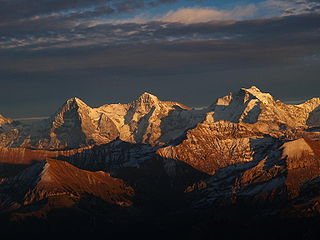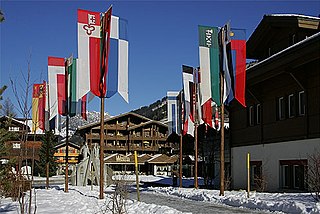| Hahnenmoos Pass | |
|---|---|
The Hahnenmoos Pass in winter | |
| Elevation | 1,950 m (6,398 ft) |
| Traversed by | Trail (dead end road) |
| Location | Bern, Switzerland |
| Range | Bernese Alps |
| Coordinates | 46°27′11″N7°29′42″E / 46.45306°N 7.49500°E Coordinates: 46°27′11″N7°29′42″E / 46.45306°N 7.49500°E |
The Hahnenmoos Pass (German: Hahnenmoospass) is a mountain pass of the Bernese Alps. The pass crosses the col between the peaks of Regenboldshorn and Albristhorn, at an elevation of 1,950 m (6,400 ft). The Hahnenmoos Pass is the lowest pass between the Engstligental, to the east, and the upper Simmental, to the west. [1]

German is a West Germanic language that is mainly spoken in Central Europe. It is the most widely spoken and official or co-official language in Germany, Austria, Switzerland, South Tyrol (Italy), the German-speaking Community of Belgium, and Liechtenstein. It is also one of the three official languages of Luxembourg and a co-official language in the Opole Voivodeship in Poland. The languages which are most similar to German are the other members of the West Germanic language branch: Afrikaans, Dutch, English, the Frisian languages, Low German/Low Saxon, Luxembourgish, and Yiddish. There are also strong similarities in vocabulary with Danish, Norwegian and Swedish, although those belong to the North Germanic group. German is the second most widely spoken Germanic language, after English.

A mountain pass is a navigable route through a mountain range or over a ridge. Since many of the world's mountain ranges have presented formidable barriers to travel, passes have played a key role in trade, war, and both human and animal migration throughout Earth's history. At lower elevations it may be called a hill pass. The highest vehicle-accessible pass in the world appears to be Mana Pass, located in the Himalayas on the border between India and Tibet, China.

The Bernese Alps are a mountain range of the Alps, located in western Switzerland. Although the name suggests that they are located in the Berner Oberland region of the canton of Bern, portions of the Bernese Alps are in the adjacent cantons of Valais, Fribourg and Vaud, the latter being usually named Fribourg Alps and Vaud Alps respectively. The highest mountain in the range, the Finsteraarhorn, is also the highest point in the canton of Bern.
Contents
The pass is traversed by a hiking track, which connects Adelboden, at an elevation of 1,350 m (4,430 ft) in the Engstligental, with Lenk, at an elevation of 1,068 m (3,504 ft) in the Simmental. The track forms part of the Alpine Pass Route, a long-distance hiking trail across Switzerland between Sargans and Montreux. Although a road leads to the pass from Adelboden, the pass can not be traversed by car. [1] [2]

Adelboden is a mountain village and a municipality in Switzerland, located in the Frutigen-Niedersimmental administrative district in the Bernese Highlands.

Lenk im Simmental is a municipality in the Obersimmental-Saanen administrative district in the canton of Bern in Switzerland.
The Alpine Pass Route is a long-distance hiking trail through the Alps in Switzerland, part of the Via Alpina route. It starts in Sargans in eastern Switzerland, and crosses the heart of country westwards to finish in Montreux on the shore of Lake Geneva. The total route covers over 325 kilometres (202 mi) and crosses 16 mountain passes, and takes 15 or more walking days to complete.
In winter the pass is part of a ski area. The Berghotel Hahnenmoospass is a hotel and restaurant that is located at the summit of the pass and is open in both summer and winter. [3]















